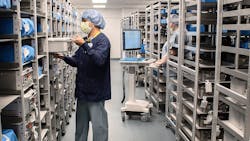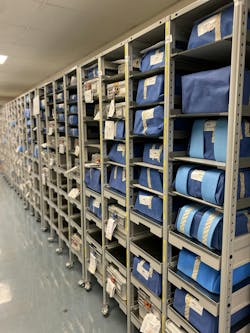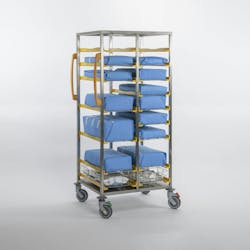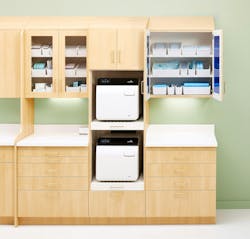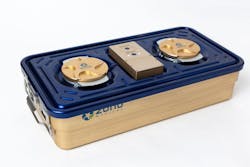Instrument Containment, Transport and Storage Success Stories
Effectively and safely containing, storing, and transporting instruments, devices, and supplies involves collaboration among many stakeholders, from sterile processing (SP) professionals to end user clinicians and everyone in between.
HPN presents two stories of healthcare organizations that made improvements in these processes, including why and how they did it and the resulting benefits. We also include some of the latest product innovations aimed at containment, storage, and transport success.
A health system wide standardized approach to transport
“Transportation of contaminated items is one of the most important factors to consider when working to eliminate the potential risk for cross contamination for visitors, patients, and workers in the healthcare setting,” said Randalyn Harreld, clinical education manager, Belimed, who led a process improvement initiative that tackled this exact issue.
The subject of the initiative was a health system located in the Southern U.S. with three hospitals, three ambulatory surgery centers (ASC), and 78 clinics. Couriers and end users were complaining of untimely delivery of items and case delays stemming from issues in the delivery process.
The investigation and findings
Harreld and team, in collaboration with the health system’s infection control team, began an inspection of the clinic courier process, including the carts, transport bins, and vehicles. They rode along in the vehicles to observe the courier process, conducted assessments of every end user, including the clinics, and spent hours in decontamination receiving.
After visiting just 12 of the 76 clinics and noticing not one was compliant with internal policies and procedures and U.S. Occupational Safety and Health Administration (OSHA) regulations, they had enough justification to move forward with a system-wide transport standardization project.
“We found a mix of clean and dirty items were being transported right next to each other in the same vehicles with things sliding around, including dietary items,” Harreld explained. “The safety risk and lack of compliance was enough justification for me to ask the organization, ‘Can we launch a project to dive into this?’”
The scope
They secured approval and funding for the project and dove into it. They found the internal operating rooms (OR) were not affected because transport of contaminated items was performed with enclosed case carts and a dedicated lift. In Harreld’s words, “This project was really a focus on everyone else.”
“That’s pretty much any patient care area in any organization using some form of device that must be transported, whether it is carried to an on-site soiled utility room for high level disinfection (HLD) or transported from off-site via courier to the main hospital’s SP department,” she stated.
Because the scope of required transport improvements was so wide reaching, engaging all impacted stakeholders was critical to the project’s success. This included the infection control team, clinical leadership, SP leaders, and the director of logistics who oversaw the couriers.
The initiative
The resulting system-wide standardized policy and procedure for transport included new processes, new products, new courier pathways, new logistical tracking, and in-depth education and training for all acute and non-acute care site teams and couriers.
“We implemented the use of dedicated courier vehicles so that items that had previously been transported in one vehicle, including dietary items and equipment, were transitioned to separate clean and dirty vehicles,” said Harreld. “We also incorporated soak bins for many ortho items and HLD items and purchased red biohazard OSHA approved leak proof bins for clinics and outside customers.”
It also encompassed instrument vendors, including a standardized process for transporting loaner trays on a dedicated pathway, a specific room/area where they could label the trays and identify them, as well as a soiled area for point of use (POU) care.
The results
A final audit revealed zero non-compliance findings related to transport throughout the health system.
“It was a massive win from an infection control perspective,” said Harreld.
In addition to the safety and compliance improvements, the initiative also improved instrument traceability. Prior to the project, couriers would use paper and pen on a clipboard to document when items were picked up and dropped off.
“Many items were being transported in biohazard bags with no labeling,” Harreld explained. “The traceability was lost, and instruments were getting dropped off at the wrong locations.”
Implementation of instrument tracking software replaced piecemeal manual documentation with end-to-end electronic traceability.
While pre-treatment at the POU was not a primary aim of the project, the team’s work served to improve this process as well. During the inspection process, they found 60 out of 78 clinics had no POU pre-treatment spray. In Harreld’s words, “They didn't know what they were supposed to use or how to order it.”
Alongside delivery of the new transport containers to the clinics, Harreld and team provided bottles of pre-treatment spray. They conducted in-servicing on both the containers and the spray, so clinic staff members understood the importance of POU treatment, how to use the spray, and how to procure more.
Advice to others
Faced with a project of this scope, which required the purchase of new containers among other items, other healthcare organizations are likely to question how they can secure the budget to perform a similar transport turnaround. Harreld offered this advice:
“In order to secure appropriate budget, you must gain the support of all stakeholders. Don’t expect all the funds to be allocated from the SP department. In our case, I separated the cost out for every clinic in an Excel spreadsheet and sent each clinic director the amount they were required to pay. With all clinics on board, I was able to secure bulk discounts for better pricing. Therefore, my advice is to push the clinical departments and locations to help with project funding.”
Pennsylvania Hospital’s “best practice” storage solution
The central processing department team at Pennsylvania Hospital in Philadelphia had been struggling with a double wire rack system in its instrument storage space. The racks were challenging for staff members to move and necessitated stacking of sets. The system was on tracks, preventing the team from customizing the racks to meet their needs.
“Our storeroom is very old, and we have no room to expand,” Pennsylvania Hospital Central Processing Department Associate Director, Ryan R. Cashman, CRCST explained. “We wanted the flexibility to easily change the layout and maximize the space we had to work with.”
A scalable solution
Cashman and team turned to DSI for a solution and selected the company’s Sterileshelf clean storage technology.
“DSI checked all the boxes for us, and they were very detailed, giving us multiple options,” said Cashman. “With the Sterileshelf system, we could adjust the shelf to what is needed for each set, allowing us to put more sets in each row. They are also on wheels so we can easily move them at any time.”
The results
Cashman commented on the benefits his department has derived from the Sterileshelf system:
“We noticed a reduction in holes in wrapped sets. And in our most recent accreditation survey, the surveyor commented on how clean and organized everything was. She said, ‘now this is best practice.’”
Advice to others
When asked to offer his advice to other sterile processing leaders planning to optimize their storage space, Cashman stated:
“In hindsight, we should have phased in the install. It was a big undertaking to do our entire storeroom in one weekend. I recommend breaking it up into smaller sections as it does take time to get the initial setup just right. For us we had to have all old racks removed, relocate the instruments temporarily, then move them to their new location. It’s a lot of work for one weekend, but once it is done it’s well worth it.”
Spotlight on containment, transport, and storage solutions
HPN reached out to suppliers of solutions in this space so they could share some of their latest innovations. Here is what they provided.
Case Medical SteriTite containers and DIN-sized stainless steel transport carts
“At Case Medical, we look for holistic solutions for instrument processing with reusable equipment, the necessary consumables for use, and software to manage the assets with barcode scanning to provide real time information,” said Marcia Frieze, CEO, Case Medical. “We pioneered the ability to rapidly configure instrument sets for ease of assembly and for instrument protection. Further we have provided folks in SPD with case carts and shelving designed for supplies and for DIN-sized containers utilizing stainless steel material for durability and adjustable shelves for fit.”
While Case Medical is best known for its SteriTite container system, Frieze said they understand how healthcare facilities require a way to manage them, identify the contents, and provide information to meet their ever-changing requirements and needs. The company designed its SteriTite containers to be universally compatible with all sterilization modalities and devices that can be sterilized.
Recently, Case Medical received a new U.S. Food and Drug Administration (FDA) 510(k) for its SteriTite solid bottom container.
“By eliminating the need for bottom filters, we can reduce weight and waste, save money, and address the ergonomic concerns of users,” said Frieze. “Importantly, solid bottom containers can now be used for secure transport of used items, pretreated at point of use with an enzymatic cleaner, reducing reprocessing time and contributing to safer patient outcomes.”
DSI Sterileshelf clean storage technology
DSI’s Sterileshelf is resistant to a high degree of usage, ensuring a long lifespan, even in heavy-duty applications. The Sterileshelf can withstand exposure to chemicals, solvents, and corrosive substances without degrading or losing its structural integrity. It is impervious to water, humidity, and moisture, preventing warping, swelling, and mold growth. DSI’s Sterileshelf material can endure high temperatures and is suitable for environments where heat exposure is common. The non-porous surface of Sterileshelf is easy to clean and maintain, which is critical to infection control in hospital applications.
HALYARD* and BELINTRA STERISYSTEM case carts
The HALYARD* and BELINTRA STERISYSTEM offers quality equipment and sterile wrap that keep staff and patients safe, whether supplies are being transported from the SP department or the OR.
The new STERISYSTEM Stericarts, redesigned with customer feedback in mind, are available in a variety of sizes and configurations.
“The STERISYSTEM Stericarts offer an efficient and effective solution for delivering the SPD’s owned, vendor and consigned instrument trays to the OR intact,” says Cory Ezell, North American Sales Director for BELINTRA, partnering with O&M Halyard.
The new STERISYSTEM Stericarts provide many benefits that make them a reliable choice for any SPD, including:
- A flexible design, with adjustable runners to fit different tray sizes to help prevent stacking
- Removeable shelves that reduce tray touchpoints from sterilization to the OR
- Front loading shelves that improve organization and increase label visibility in the OR
- A lighter build with double caster wheels for ease of movement and maneuverability
- A clean/dirty indicator allowing for quick identification
- Ergonomic, post wash, cool touch handles to increase user safety
Midmark Synthesis Cabinetry
Synthesis Cabinetry for use in sterilization centers is designed specifically for the clinical environment to help enhance workflow, ergonomics, and infection prevention. The cabinetry incorporates ergonomic principles and is designed for the caregivers who interact with cabinetry in the medical space on a daily basis. Multiple configurations increase ergonomic storage for a leaner and more efficient clinical workflow.
Gravity-fed, angled flow shelving improves visibility and access to instruments and supplies, even for items stored toward the back of the cabinet. Optional storage accessories can enhance instrument/supply storage and organization, helping improve access to supplies and efficiency of care delivery while keeping sterile instruments located apart from contaminated instruments and protected from moisture.
Optional storage bins are available for use with the angled flow shelving and can be stacked with lay-on lids or used within 4-inch drawers. The durable construction and aseptic surfaces of the cabinetry stand up to water, steam, and heavy use of the sterilization area.
Zuno Smart Containers
Zuno Medical introduces a groundbreaking solution: the first and only sterilization container designed with a verifiable vacuum-seal and electronic monitoring to transform sterile processing for the OR. With this innovation, sterilization containers are prepped in seconds, and provide sterile barrier assurance at any location. The absence of porous barriers also allows containers to cool outside of the autoclave without risk of internal condensation and bacterial ingress, freeing up the autoclave for additional cycles.
Zuno Smart Containers mitigate costly delays and cancellations by eliminating compromised surgical instrument sets from entering the OR. Furthermore, the elimination of disposables and porous barriers not only reduce hospital waste but also reduce surgical case turnover time allowing for increased procedures.
About the Author
Kara Nadeau
Senior Contributing Editor
Kara Nadeau is Sterile Processing Editor for Healthcare Purchasing News.
